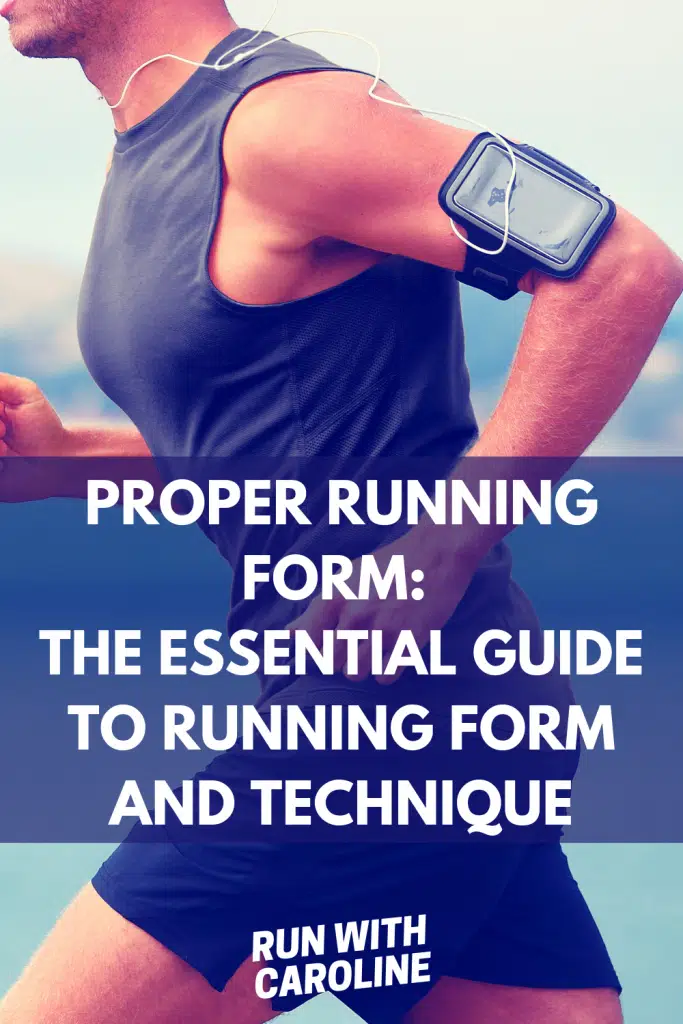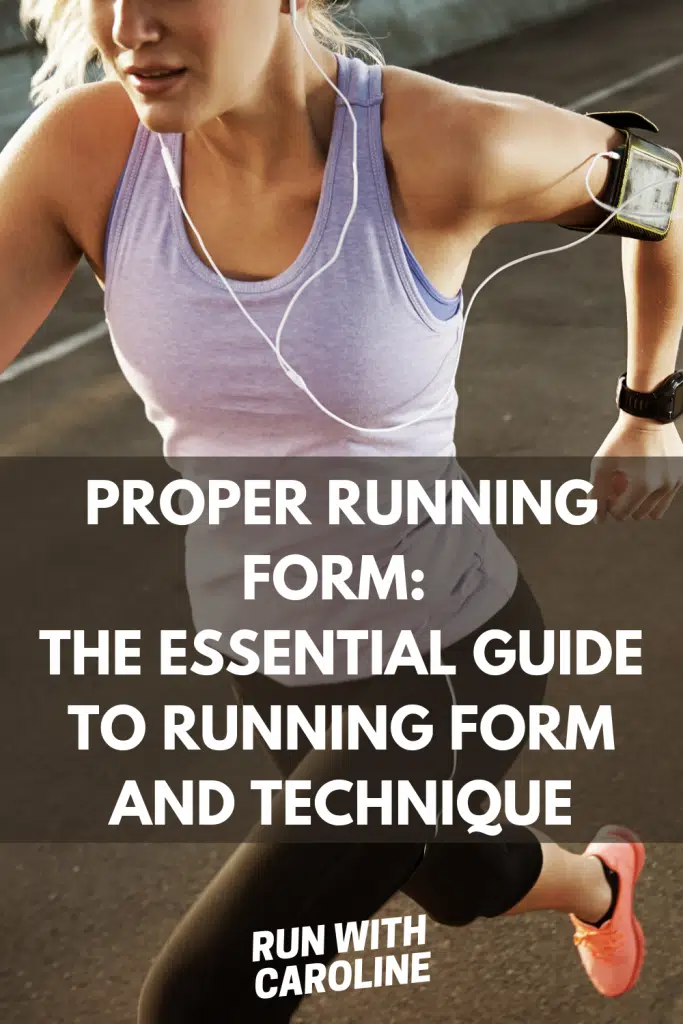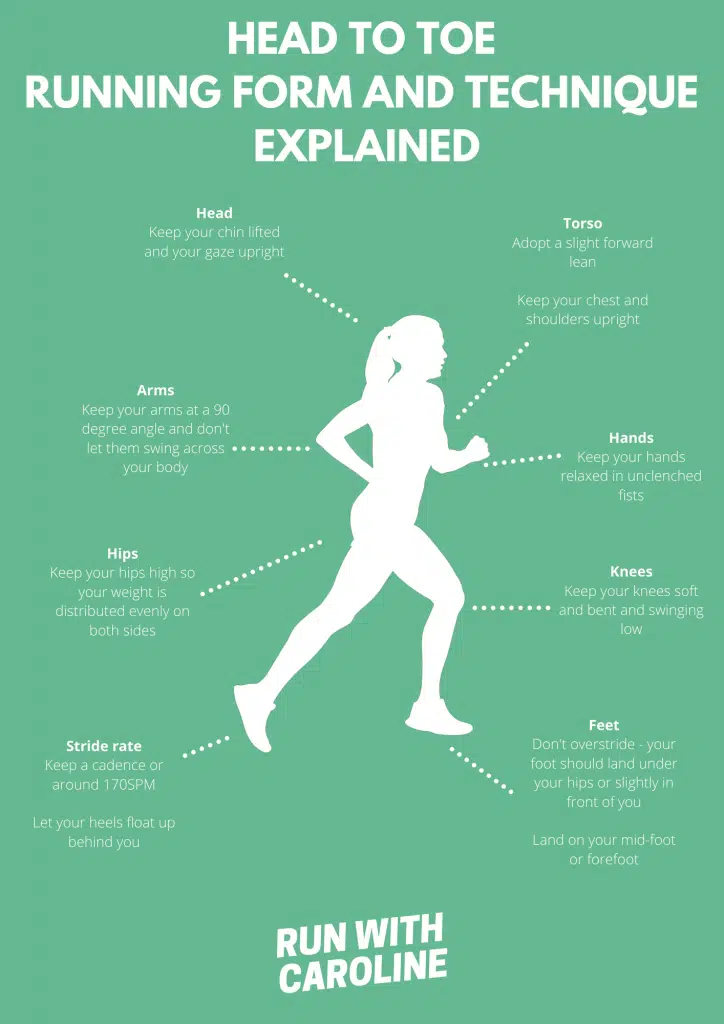There are many components that make up proper running form and technique.
Many runners don’t think about their form and technique when they start running.
While this is fine to begin with, you may want to give more thought to how you run.
Proper running form and technique is important because, if done incorrectly, it can cause imbalances in your muscles and lead to higher risk of injury.
Many runners are blighted by common running injuries like IT band syndrome, shin splints and runner’s knee.
So it’s never been more important to focus on your form.
In this guide we’ll explore:
- What is proper running form and technique?
- Why is proper running form and technique important?
- 5 key principles of proper running form and technique
Be sure to download my handy running form PDF at the end of this guide.
Ready?
Let’s go!

What is proper running form and technique?
Running form and technique is all about running in the most efficient and economical way possible.
This means placing as little stress as possible on your muscles and joints.
There are five key principles when it comes to proper running form and technique:
- Posture
- Arm swing
- Core strength
- Cadence
- Footstrike
You will find a breakdown of each core principle at the end of this guide.
Related: 4 simple tips to improve running form
Why is proper running form and technique important?
Proper running form and technique is important.
Because, when done correctly, means you drastically reduce the risk of injury, which is commonly caused by imbalances in the body.
According to a 2017 study, running technique is an important component of running economy.
It added that performance and evidence shows that running technique explains variances in running economy and that, when done correctly, ultimately enhances a runner’s performance
Here are the benefits of proper running form and technique:
- Improves performance
- Helps you run more efficiently
- Helps you run faster
- Reduces the risk of fatigue
- Reduces the risk of common running injuries like IT band syndrome and runner’s knee
- Helps you stay healthy as a runner
Related: Run faster and improve your form: How to run strides

5 key principles of proper running form and technique
Now you know about the importance of proper running form and technique, here are the five key principles of running form and technique:
- Posture
- Arm swing
- Core strength
- Cadence
- Footstrike
Be sure to read to the end of this guide where you will find my head to toe running form and technique visual which pulls all the key components of running form together.
#1 Posture
Good posture involves you training your body to walk and run, and indeed sit and lie, in positions where the least strain is placed on joints, supporting muscles and ligaments during movement.
Posture whilst running is key to head to toe running form and technique.
This is because it ensures you don’t create imbalances in your muscles, which often lead to injuries.
For many of us as we lead our modern lives, sitting behind a desk all day creates bad posture habits.
The tendency is to hunch over, lower your shoulders and head.
You may have heard of the term ‘run tall’ in the running community.
This is basically an effort to counteract those poor posture habits so that you adopt a more efficient running form.
It’s important to note that the term “run tall” doesn’t mean to run upright – you will have a slight forward lean when you run.
Your body should appear as one long line from your ankles to your shoulders, at just a slight angle to the ground.
Put simply, imagine you have a helium balloon attached to your head with a piece of string whilst running.
Notice how this affects your posture:
- Is your head lifted?
- Are your shoulders retracted slightly?
- Are your hips lifted?
How to improve running posture:
- Stand up straight with your shoulders retracted slightly.
- Try not to look at the ground when running – keep your chin lifted and your gaze upright and forward.
- Lean (fall) slightly forward.
- Squeeze your belly button – imagine you’re pushing it back towards your spine.
- Keep your hips high, so that your weight is distributed evenly on both hips.
#2 Arm swing
Your arms play a vital role when you run to help you run faster and more efficiently.
Your arms help to stabilise your body as you run.
How you hold and swing your arms can even make a difference to your stride, performance and can even lower your risk of injury.
A simple way to understand how important your arms are to head to toe running form and technique is to run with your arms relaxed by your sides.
You’ll notice straight away that this creates additional work for your back, hips and legs. It will also feel very uncomfortable!
The key with proper arm swing is to try and not let your arms swing across your body when you run.
If you let your arms cross your body too much, it will cause unnecessary rotation in your spine and thorax and will lead to inefficient running form.
How to improve running arm swing:
- Swing your arms from your shoulders, not from your elbows.
- Drive your elbows back, keep them close to your sides of your body as you run.
- Don’t let your arms cross your body when you run.
- Keep your arms at a 90 degree angle – try not to straighten them out too much or have them too bent as this will affect how you propel your body forward.
- Keep your arms relaxed to avoid stiffness in your shoulders.
- Keep your hands relaxed – unclench your fists. Imagine you are holding a penny in between your thumb and forefinger.
Related: Proper arm swing and 5 ways to improve it

#3 Core strength
Proper running form and technique is supported by a good core.
A good core means you are able to hold a strong and stable position for longer, thus allowing you to hold proper form and posture.
Your back and stomach muscles are key components for good core strength.
Unfortunately, running alone won’t improve your core strength, you need to dabble in strength exercises as well as running to really see results.
How to improve core strength:
There are lots of core strength exercises you can do to improve your core strength. Here are just a few that I recommend:
- Hollow body holds
- Plank
- Superman pull
- Bicycle crunches
- Side plank dips
- Dead bugs
Related: 7 essential core exercises every runner should do
#4 Cadence
Your cadence is the amount of steps you take per minute when you run and it plays an important role when it comes to head to toe running form and technique.
Running cadence for beginners can be confusing, but arguably, it is one of the simplest parts of running form to master.
If you have a low cadence, you will likely have a long stride which means you overstride when you run.
Overstriding is when your foot lands in front of your body when running.
When you overstride, your heel tends to hit the ground first (also known as ‘heel strike’) which causes impact forces to travel up your foot, into your knee and hip.
Over time, this can cause stress and pressure in your leg which leads to injury.
The optimal cadence is around 170 steps per minute.
This will vary slightly depending on your weight, height and running experience, as well as the number of miles you are running.
You can measure your cadence by counting the number of strides you take for 30 seconds then multiply this figure by two.
The key thing when doing this is to maintain a consistent pace as you count.
Once you have a baseline figure, you can increase your cadence incrementally.
An increased cadence helps to prevent many running-related injuries, such as runner’s knee and IT band syndrome.
How to improve running cadence:
- Imagine you are running on ice – take short strides and increase your stride rate.
- Download a metronome app to help you increase your cadence.
- Download songs that have 170 beats per minute.
- Do some running drills in your warm up. Butt kicks, A-skips, fast feet and high knees can all help to increase your cadence.
Related: 4 ways to improve running cadence

#5 Footstrike
The way your foot hits the ground (also called ‘footstrike’) is key when it comes to proper running form and technique.
There are three types of footstrike:
- Heel footstrike
- Mid-foot footstrike
- Forefoot footstrike
There isn’t a proven favourite in the running community.
However, the mid-foot footstrike is seen to be a happy medium.
This is because when your foot hits the ground, a mid-foot strike means your weight is distributed more evenly.
This therefore reduces the amount of impact force up your leg and decreasing your risk of injury.
If you don’t know what footstrike you have, a good tip is to ask someone to film you while you run from the side.
Watch the video back and focus on your feet as they hit the ground. Here are the key characteristics of each footstrike:
- Heel footstrike. Your foot lands in front of your body and your heel hits the ground first.
- Mid-foot strike. Your foot lands under or slightly in front of your hips and the middle of your foot hits the ground first.
- Forefoot footstrike. Your foot lands under or slightly in front of your hips and the front of your foot hits the ground first.
How to improve running footstrike:
- Increase your cadence – an increased stride rate will help to reduce overstriding.
- Wear comfortable running shoes.
- Practice running technique drills that help you to adopt a more neutral, mid-foot footstrike.
- Practice! You won’t change your footstrike overnight. It will take time so don’t put too much pressure on yourself to get it right first time.
Related: Proper running footstrike and how to improve it
Proper running form and technique explained: Putting it all together
Here is my handy running technique PDF which explains all the key components of head to toe running form and technique.
This is a great resource to explain running technique for beginners.

- 5 things I wish I’d known before returning to running - March 3, 2024
- Running 20 minutes a day: Benefits + how to start - January 27, 2024
- How to run your first 2 hour half marathon - January 16, 2024
